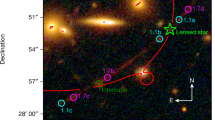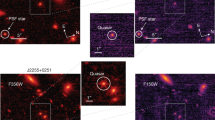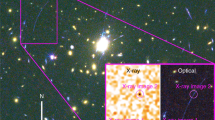Abstract
The tight correlations found between the mass of supermassive black holes and the luminosities, stellar masses and velocity dispersions of their host galaxies are often interpreted as a sign of their co-evolution. Studying these correlations across redshift provides a powerful insight into the evolutionary path followed by the quasar and its host galaxy. While the mass of the black hole is accessible from single-epoch spectra, measuring the mass of its host galaxy is challenging as the active nucleus largely overshines its host. Here we present a technique to probe quasar–host relations beyond the local Universe with strong gravitational lensing, hence overcoming the use of stellar population models or velocity dispersion measurements, both prone to degeneracies. We study in detail one of the three known cases of strong lensing by a quasar to accurately measure the mass of its host and to infer a total lensing mass within the Einstein radius. The lensing measurement is more precise than any other alternative technique and compatible with the local scaling relation between the mass of the black hole and the stellar mass. The sample of such quasar–galaxy or quasar–quasar lensing systems should reach a few hundred with Euclid and the Rubin-Large Synoptic Survey Telescope, thus enabling the application of such a method with statistically significant sample sizes.
This is a preview of subscription content, access via your institution
Access options
Access Nature and 54 other Nature Portfolio journals
Get Nature+, our best-value online-access subscription
$29.99 / 30 days
cancel any time
Subscribe to this journal
Receive 12 digital issues and online access to articles
$119.00 per year
only $9.92 per issue
Buy this article
- Purchase on Springer Link
- Instant access to full article PDF
Prices may be subject to local taxes which are calculated during checkout


Similar content being viewed by others
Data availability
The HST images supporting this work are publicly available on the Hubble Legacy Archive (https://hla.stsci.edu/). Our reduced Keck and SDSS spectra are available on Zenodo (https://doi.org/10.5281/zenodo.7806468).
Code availability
The lens modelling code Lenstronomy and the source reconstruction software SLITronomy are freely accessible at https://github.com/sibirrer/lenstronomyand https://github.com/aymgal/SLITronomy. Stellar masses were estimated by using the public python package GSF (https://github.com/mtakahiro/gsf). The HST PSF was reconstructed using AstroObjectAnalyser, which is publicly available at https://github.com/sibirrer/AstroObjectAnalyser. Spectra have been fitted using pyQSOfit, which is also publicly available at https://github.com/legolason/PyQSOFit.
References
Courbin, F. et al. Three quasi-stellar objects acting as strong gravitational lenses. Astron. Astrophys. 540, A36 (2012).
Ferrarese, L. & Merritt, D. A fundamental relation between supermassive black holes and their host galaxies. Astrophys. J. 539, L9–L12 (2000).
Gebhardt, K. et al. A relationship between nuclear black hole mass and galaxy velocity dispersion. Astrophys. J. 539, L13–L16 (2000).
Springel, V. et al. Simulations of the formation, evolution and clustering of galaxies and quasars. Nature 435, 629–636 (2005).
Di Matteo, T., Colberg, J., Springel, V., Hernquist, L. & Sijacki, D. Direct cosmological simulations of the growth of black holes and galaxies. Astrophys. J. 676, 33–53 (2008).
Peng, C. Y. How mergers may affect the mass scaling relation between gravitationally bound systems. Astrophys. J. 671, 1098–1107 (2007).
Kormendy, J. & Ho, L. C. Coevolution (or not) of supermassive black holes and host galaxies. Annu. Rev. Astron. Astrophys. 51, 511–653 (2013).
Sexton, R. O. et al. Stronger constraints on the evolution of the MBH–σ⋆ relation up to z ~ 0.6. Astrophys. J. 878, 101 (2019).
Ding, X. et al. The mass relations between supermassive black holes and their host galaxies at 1 < z < 2 HST-WFC3. Astrophys. J. 888, 37 (2020).
Ding, X. et al. Testing the evolution of correlations between supermassive black holes and their host galaxies using eight strongly lensed quasars. Mon. Not. R. Astron. Soc. 501, 269–280 (2021).
Jahnke, K. et al. Massive galaxies in COSMOS: evolution of black hole versus bulge mass but not versus total stellar mass over the last 9 Gyr? Astrophys. J. 706, L215–L220 (2009).
Schramm, M. & Silverman, J. D. The black hole-bulge mass relation of active galactic nuclei in the Extended Chandra Deep Field-South Survey. Astrophys. J. 767, 13 (2013).
Schulze, A. & Wisotzki, L. Accounting for selection effects in the BH–bulge relations: no evidence for cosmological evolution. Mon. Not. R. Astron. Soc. 438, 3422–3433 (2014).
Woo, J. H. in Panoramic Views of Galaxy Formation and Evolution, vol. 399 (eds Kodama, T., Yamada, T. & Aoki, K.) (Astronomical Society of the Pacific, 2008).
Treu, T., Woo, J.-H., Malkan, M. A. & Blandford, R. D. Cosmic evolution of black holes and spheroids. II. Scaling relations at z = 0.36. Astrophys. J. 667, 117–130 (2007).
Cen, R. Coevolution between supermassive black holes and bulges is not via internal feedback regulation but by rationed gas supply due to angular momentum distribution. Astrophys. J. Lett. 805, L9 (2015).
Lauer, T. R., Tremaine, S., Richstone, D. & Faber, S. M. Selection bias in observing the cosmological evolution of the Mffl–σ and Mffl–L relationships. Astrophys. J. 670, 249–260 (2007).
Claeskens, J. F., Lee, D. W., Remy, M., Sluse, D. & Surdej, J. QSO mass constraints from gravitational lensing studies of quasar pairs. The cases of Q1548+114 A & B and Q1148+0055 A & B. Astron. Astrophys. 356, 840–848 (2000).
Meyer, R. A., Delubac, T., Kneib, J.-P. & Courbin, F. Quasi-stellar objects acting as potential strong gravitational lenses in the SDSS-III BOSS survey. Astron. Astrophys. 625, A56 (2019).
Taak, Y. C. & Im, M. High-z Universe probed via lensing by QSOs (HULQ). I. Number estimates of QSO–QSO and QSO–galaxy lenses. Astrophys. J. 897, 163 (2020).
Galan, A., Peel, A., Joseph, R., Courbin, F. & Starck, J. L. SLITRONOMY: towards a fully wavelet-based strong lensing inversion technique. Astron. Astrophys. 647, A176 (2021).
Suyu, S. H. et al. Dissecting the gravitational lens B1608+656. II. Precision measurements of the Hubble constant, spatial curvature, and the dark energy equation of state. Astrophys. J. 711, 201–221 (2010).
Despali, G. et al. Detecting low-mass haloes with strong gravitational lensing I: the effect of data quality and lensing configuration. Mon. Not. R. Astron. Soc. 510, 2480–2494 (2022).
Grier, C. J. et al. Stellar velocity dispersion measurements in high-luminosity quasar hosts and implications for the AGN black hole mass scale. Astrophys. J. 773, 90 (2013).
Letawe, G. et al. On-axis spectroscopy of the host galaxies of 20 optically luminous quasars at z ~0.3. Mon. Not. R. Astron. Soc. 378, 83–108 (2007).
Millon, M. et al. TDCOSMO. I. An exploration of systematic uncertainties in the inference of H0 from time-delay cosmography. Astron. Astrophys. 639, A101 (2020).
Park, D. et al. Extending the calibration of C IV-based single-epoch black hole mass estimators for active galactic nuclei. Astrophys. J. 839, 93 (2017).
Bahk, H., Woo, J.-H. & Park, D. Calibrating Mg II-based black hole mass estimators with Hβ reverberation measurements. Astrophys. J. 875, 50 (2019).
Bertin, E. & Arnouts, S. SExtractor: software for source extraction. Astron. Astrophys. Suppl. Ser. 117, 393–404 (1996).
Birrer, S. et al. lenstronomy II: A gravitational lensing software ecosystem. J. Open Source Softw. 6, 3283 (2021).
Bolton, A. S., Burles, S., Koopmans, L. V. E., Treu, T. & Moustakas, L. A. The Sloan Lens ACS Survey. I. A large spectroscopically selected sample of massive early-type lens galaxies. Astrophys. J. 638, 703–724 (2006).
Shajib, A. J., Treu, T., Birrer, S. & Sonnenfeld, A. Dark matter haloes of massive elliptical galaxies at z ~ 0.2 are well described by the Navarro–Frenk–White profile. Mon. Not. R. Astron. Soc. 503, 2380–2405 (2021).
Refregier, A. Shapelets - I. A method for image analysis. Mon. Not. R. Astron. Soc. 338, 35–47 (2003).
Birrer, S., Amara, A. & Refregier, A. Gravitational lens modeling with basis sets. Astrophys. J. 813, 102 (2015).
Joseph, R., Courbin, F., Starck, J. L. & Birrer, S. Sparse lens inversion technique (SLIT): lens and source separability from linear inversion of the source reconstruction problem. Astron. Astrophys. 623, A14 (2019).
Starck, J.-L., Fadili, J. & Murtagh, F. The undecimated wavelet decomposition and its reconstruction. IEEE Trans. Image Process. 16, 297–309 (2007).
Abazajian, K. N. et al. The seventh data release of the Sloan Digital Sky Survey. Astrophys. J. Suppl. 182, 543–558 (2009).
Guo, H., Shen, Y. & Wang, S. PyQSOFit: Python code to fit the spectrum of quasars (Astrophysics Source Code Library, 2018); http://ascl.net/1809.008
Yip, C. W. et al. Spectral classification of quasars in the Sloan Digital Sky Survey: eigenspectra, redshift, and luminosity effects. Astron. J. 128, 2603–2630 (2004).
Schlegel, D. J., Finkbeiner, D. P. & Davis, M. Maps of dust infrared emission for use in estimation of reddening and cosmic microwave background radiation foregrounds. Astrophys. J. 500, 525–553 (1998).
Mejía-Restrepo, J. E., Trakhtenbrot, B., Lira, P., Netzer, H. & Capellupo, D. M. Active galactic nuclei at z ~ 1.5 – II. Black hole mass estimation by means of broad emission lines. Mon. Not. R. Astron. Soc. 460, 187–211 (2016).
Liu, H.-Y. et al. A comprehensive and uniform sample of broad-line active galactic nuclei from the SDSS DR7. Astrophys. J. Suppl. 243, 21 (2019).
Ho, L. C. & Kim, M. A revised calibration of the virial mass estimator for black holes in active galaxies based on single-epoch Hβ spectra. Astrophys. J. 809, 123 (2015).
Morishita, T. et al. Massive dead galaxies at z ~ 2 with HST Grism spectroscopy. I. Star formation histories and metallicity enrichment. Astrophys. J. 877, 141 (2019).
Park, D. et al. Cosmic evolution of black holes and spheroids. V. The relation between black hole mass and host galaxy luminosity for a sample of 79 active galaxies. Astrophys. J. 799, 164 (2015).
Bell, E. F. & de Jong, R. S. Stellar mass-to-light ratios and the Tully–Fisher relation. Astrophys. J. 550, 212–229 (2001).
Binney, J. & Tremaine, S. Galactic Dynamics (Princeton University Press, 1987).
Häring, N. & Rix, H.-W. On the black hole mass–bulge mass relation. Astrophys. J. 604, L89–L92 (2004).
Bennert, V. N., Auger, M. W., Treu, T., Woo, J.-H. & Malkan, M. A. A local baseline of the black hole mass scaling relations for active galaxies. I. Methodology and results of pilot study. Astrophys. J. 726, 59 (2011).
Acknowledgements
M.M. acknowledges the support of the Swiss National Science Foundation (SNSF) under grant P500PT_203114. M.M., F.C. and A.G. are supported by the European Research Council (ERC) under the European Union’s Horizon 2020 research and innovation programme (COSMICLENS: grant agreement no. 787886) and the Swiss National Science Foundation (SNSF) under grant 200020_200463. X.D. is supported by JSPS KAKENHI grant no. JP22K14071.
Author information
Authors and Affiliations
Contributions
M.M. conducted the analysis. A.G. developed the source reconstruction algorithm SLITronomy. M.M. and F.C wrote the manuscript. X.D. did the stellar population analysis. D.S. measured the black hole mass. All other co-authors actively participated in the discussions, in the HST data acquisition and in the discovery process of SDSS J0919 + 2720.
Corresponding author
Ethics declarations
Competing interests
The authors declare no competing interest.
Peer review
Peer review information
Nature Astronomy thanks the anonymous reviewers for their contribution to the peer review of this work.
Additional information
Publisher’s note Springer Nature remains neutral with regard to jurisdictional claims in published maps and institutional affiliations.
Supplementary information
Supplementary Information
Supplementary Figs. 1–3 and Table 1.
Rights and permissions
Springer Nature or its licensor (e.g. a society or other partner) holds exclusive rights to this article under a publishing agreement with the author(s) or other rightsholder(s); author self-archiving of the accepted manuscript version of this article is solely governed by the terms of such publishing agreement and applicable law.
About this article
Cite this article
Millon, M., Courbin, F., Galan, A. et al. Strong gravitational lensing by AGNs as a probe of the quasar–host relations in the distant Universe. Nat Astron 7, 959–966 (2023). https://doi.org/10.1038/s41550-023-01982-2
Received:
Accepted:
Published:
Issue Date:
DOI: https://doi.org/10.1038/s41550-023-01982-2
This article is cited by
-
A new lens for quasar host masses
Nature Astronomy (2023)




